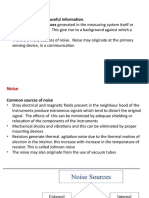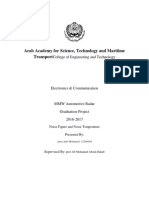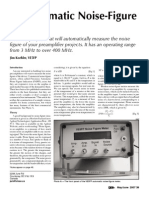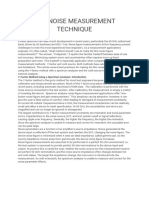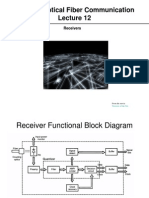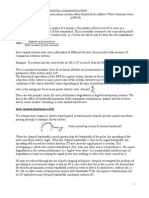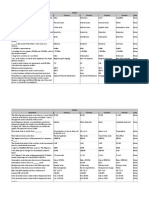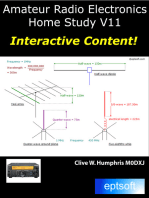Application Note Noise Frequently Asked Questions: Plot of Voltage Distribution of Noise Source 0 V
Application Note Noise Frequently Asked Questions: Plot of Voltage Distribution of Noise Source 0 V
Uploaded by
Muhammad JahanzaibCopyright:
Available Formats
Application Note Noise Frequently Asked Questions: Plot of Voltage Distribution of Noise Source 0 V
Application Note Noise Frequently Asked Questions: Plot of Voltage Distribution of Noise Source 0 V
Uploaded by
Muhammad JahanzaibOriginal Title
Copyright
Available Formats
Share this document
Did you find this document useful?
Is this content inappropriate?
Copyright:
Available Formats
Application Note Noise Frequently Asked Questions: Plot of Voltage Distribution of Noise Source 0 V
Application Note Noise Frequently Asked Questions: Plot of Voltage Distribution of Noise Source 0 V
Uploaded by
Muhammad JahanzaibCopyright:
Available Formats
Application Note Noise Frequently Asked Questions
Noise: Frequently Asked Questions What is Noise? Noise is a random signal inherent in all physical components. It directly limits the detection and processing of all information. The common form of noise is white Gaussian due to the many random processes that make up electric currents or thermal agitation of conductive elements. Why is it Important? Because electronic noise is ubiquitous, present in all passive and active components, it is critical for engineers to characterize and understand how it limits the transmission of information. What does the term Gaussian signify? The term Gaussian refers to the voltage distribution of the source of noise. Due to its random nature the noise voltage of a component is usually a Gaussian distribution. This is characterized by its mean value and random voltage excursions that follow a bell shaped Gaussian curve
Plot of voltage distribution of noise source =0 V
Voltage of noise source versus time
What does the term White signify? White refers to the noise source power spectral density, which is ideally flat with frequency. In reality at some point often due to mismatch there is a reduction in the measurable noise level What is AWGN? Additive White Gaussian Noise (AWGN) is a term to refer to the fact that noise eventually combines with the desired signal and is a major limiting factor in the transmission of information.
11 Melanie Lane East Hanover, NJ 07936
info@noisewave.com www.noisewave.com Phone: (973) 386-1119 Fax: (973) 386-1131
Application Note Noise Frequently Asked Questions
What are the common usages of a noise source? Noise Sources are used to measure Noise Figure, provide a source of AWGN to generate CNR or EbNo to measure error rates, and are used as an economical source of broad band power for built in test applications such as signal strength calibrators and radar applications . They can be used to increase the dynamic range of Analog to Digital converters by dithering and reducing correlated noise. They are often found in Disk drive testing, wireless testing, CATV both analog and DOCSYS, jamming, SATCOM for BER and NF, as well employed as a source of jitter. What types of noise sources are available? Noise sources can be a simple noise diode which generates a low level of noise, to amplified noise sources supplied in multiple form factors to instrumentation grade noise generators which amplify, attenuate and process both the noise and a user added signal. Noise diodes come in a variety of packages and can be surface mount or DIP for PCB mount or coaxial for system integration. What is ENR? ENR refers to Excess Noise Ratio which is 10 log {(Th-290)/290} essentially a normalized measure of how much the noise source is above thermal in its power. At high ENRs > 15 dB the density of power can be approximated by adding the ENR to -174 dBm/Hz. How are noise sources tested and specified? Noise sources are typically tested depending on their output level. Noise Sources that are used in Noise Figure applications are typically 6 to 30 dB in ENR. These usually require a Noise Figure Meter or a dedicated noise radiometer due to their low power levels. Since the ENR value is used to calculate the Noise Figure directly low power noise sources typically are supplied with calibrated ENR values. Higher power noise sources typically are supplied with aggregate power measurements such as on a power meter with spectral flatness observed on a spectrum analyzer. What is the crest factor of a noise source? Noise Sources are characterized by their crest factor, which is the peak to average ratio of the noise. For example a 5:1 crest factor of the noise voltage is 20 log5 =14 dB. This is a measure of the quality of the noise distributions and one way to measure its Gaussian nature. Noise theoretically has an unbounded distribution so that it should have an infinite crest factor but the physical realization of the noise generator will limit the output excursions, via the amplifiers, diode junctions etc. Why and when is crest factor important? Crest factor is important primarily in Bit Error Rate applications. In low power applications in which noise powers are being compared such as NF, it is largely insignificant. In BER applications it is important because the BER being measured is a direct function of the Carrier to Noise ratio, and if these noise excursions do not occur as expected the errors will fall off and the erroneous results will occur. One important note is that it is the crest factor of the resultant noise in the receiver and its bandwidth that
11 Melanie Lane East Hanover, NJ 07936 info@noisewave.com www.noisewave.com Phone: (973) 386-1119 Fax: (973) 386-1131
Application Note Noise Frequently Asked Questions
will determine the resultant crest factor. This is significant because often times the required noise is a much larger BW than the receiver, for example a tuned receiver operating over a wide BW requires the noise to cover the entire RF BW. This can put a strain on the realizable crest factor because the wide band high power amplifiers required to cover the entire BW can be cost prohibitive and degrade system accuracy in other ways such as excess current or reliability. Since the noise is often filtered in the receiver, the crest factor of the resultant noise is improved as the excess BW is stripped away reducing the noise power and leaving the noise farther from the clipping point. In the limit clipped noise becomes Gaussian as the measurement BW is reduced. The required crest factor should take into consideration all of the above. What is BITE? BITE stands for Built-In-Test and refers to the utilization of a noise source as a source of power to test a system. For example the noise source may be put on a PCB via a TO-8 can, dip package or surface mount with a coupler or a switch to selectively inject the noise into the circuit. By turning on the noise source and detecting the system output power the system can be verified automatically and remotely. The noise source can also be used to calibrate the receivers noise figure by comparing its know value to the receiver. Noise temperature, Noise Figure, frequency response, sensitivity and gain are among the parameters that can be measured. What is Eb/No? Eb/No stands for Energy per bit divided by Noise Density. It is essentially a normalized Carrier to Noise ratio for digital systems. Typically Eb/No is plotted versus BER to measure the effectiveness of the information transfer. What is CNR? CNR is Carrier to Noise Ratio and it is the relative power level of the carrier signal to the noise level in a system. It typically determines the quality of the system and BER is plotted against CNR. Carrier refers to the information signal in this case. What is BER? Bit error rate is the frequency of errors that occur when bits are transmitted in a digital system. Critically it is a function of signal to noise ratio or carrier to noise ratio. What is Noise Figure? Noise Figure is defined as the ratio of the signal to noise power at the input to the signal to noise power at the output of a device, in other words the degradation of the signal to noise ratio as the signal passes through the device. Since the input noise level is usually thermal noise from the source the convention is to adopt a reference temperature of 290deg K. The noise figure becomes the ratio of the total noise power output to that portion of the noise power output due to noise at input when the source is 290 deg K. Hewlett Packard App Note 57-1 describes these definitions and calculations.
11 Melanie Lane East Hanover, NJ 07936
info@noisewave.com www.noisewave.com Phone: (973) 386-1119 Fax: (973) 386-1131
Application Note Noise Frequently Asked Questions
How is noise figure measured and calculated? Noise figure is typically determined by using a calibrated noise source which is traceable to international standards. This noise source is essentially compared to the unknown noise figure and by measuring this difference noise figure is computed: NF= ENR dB-10 log (Y-1) + Tcorr Tcorr is a temperature correction factor that can be applied if the temperature deviates significantly from 290 K. Y is the Y factor which is the ratio of the output power with the noise on to the output power with the noise off . By employing this method of measuring the Y factor, only relative accuracies are significant which makes the measurement easier than attempting to measure exact powers which can be quite low and tough to measure. How do noise powers add? Noise powers add as incoherent signals which means that their powers must be added. For example if your inject a noise source into a spectrum analyzer and see that the noise floor increases 3 dB, then the actual noise source power is at the original noise floor level. This relationship allows you to calculate the noise power of signals below the measurement noise floor: 10 log [{Inverse log (diff/10)} -1)] Where diff is the dB difference in measured powers. Of course small changes in power occur as the unknown noise is far below the known and this results in increasing inaccuracy as the power goes much lower. Why cant I see my noise source on a spectrum analyzer? If you are attempting to measure a lower power noise source, < 30 dB ENR, in all probability the spectrum analyzer Noise Figure, which usually is at a minimum of 25 dB and many times is 35 dB, is above the noise level of noise source. At these levels we can approximate Noise Figure and ENR and compare directly to see if the noise source will be detectable. This source could be measured with an LNA in front of the Spectrum Analyzer although to get an exact ENR we would need to know the NF of the LNA and its gain but we can see if the approximate deflection occurs. For example a 15 dB ENR noise source should change the noise level about 10 dB if the noise figure of the LNA is about 5 dB, as long as the LNA gain is sufficient to overcome the Noise figure of the analyzer. Higher power noise sources can be measured on a spectrum analyzer for flatness and on a power meter for output power. Why test at high power levels? Sometimes it is convenient to test at higher power levels. For example BER measurements are a function of Carrier to Noise Ratio and they can be quite sensitive with large changes in BER resulting with small changes in CNR. Rather than test at low power levels that are very difficult to measure, often times it is easier to inject more noise power and test at levels that are easier to establish what is the actual CNR.
11 Melanie Lane East Hanover, NJ 07936 info@noisewave.com www.noisewave.com Phone: (973) 386-1119 Fax: (973) 386-1131
Application Note Noise Frequently Asked Questions
Also often times tests are done at lower CNR so that the BER is higher and the low BER results are extrapolated, which saves test time because the errors come so infrequently at high CNR. What is noise power spectral density? Typically referred to as No, this is the amount of power the source will output in a one hertz bandwidth. It is essentially a normalized output power. Since noise power is proportional to bandwidth, No is used to compute the power in any bandwidth. What is -174 dBm/Hz? This is a convenient number to use, it represents the amount of power in a one hertz bandwidth that a thermal noise source has at the reference temperature of 290K, which is close to room temperature. This results from the equation P= kTB where k= Boltzmanns constant, T is temp in degrees K and B is the bandwidth. For example the available thermal noise power in a resistor in a 1 MHz bandwidth would be -114 dBm because 10 log (1MHz) =60 dB is added to the -174 dBm/ Hz. What is No and how is it used to calculate noise output power? No is the noise density of the Noise Source. It is the output power per hertz that the source provides. To calculate the power that the source will have in a BW the No is added to the dB (BW). For example a -80 dBm/Hz amplified noise module with 1 GHz BW will have a minimum of -80 dBm/Hz + 10 log (1 GHz) = -80 dBm/Hz + 90 dB = +10 dBm. If this source is measured on a spectrum analyzer with the Resolution BW set to 1 MHz then -80 dBm/Hz + 10 log (1 MHz) = -20 dBm will be displayed. In actuality the noise source will have some out of band noise and the resolution BW has a noise equivalent BW greater than its setting so some adjustment of these numbers will be needed for a more accurate number. For many applications this first order approximation will suffice. Aggregate output power should be measured on a power meter, although it could be approximated by adding 10 log (BWns/RBW) to the number on the spectral analyzer. Also when performing power calculations on Noise Sources if the ENR is known the output power density can be approximately calculated by adding the ENR to -174 dBm/Hz. This is accurate to less than 0.2 dB at 15 dB ENR and less than .01 dB for ENRs greater than 30 dB. For example a 34 dB ENR noise source would have a noise spectral density of -174 dBm/Hz + 34 dB = -140 dBm/Hz. In a 10 MHz BW this would result in -140 dBm/Hz + 70 dB = -70 dBm. For lower ENRs the Th has to be solved for directly from the definition of ENR then the noise density 10 log kTh would be computed. Why is Noise Power proportional to BW? Since noise is a random signal its power is distributed over its usable bandwidth BW, and the noise source is considered white due to its constant spectral density. This results in the power measured being proportional to BW. If a certain power is measured in X BW, then if the BW is increased to 2X the power measured is double or 3 dB higher. This should be noted when measuring high level noise sources on a spectrum analyzer. This is critical because as a systems BW increases to allow for more information to be processed, this will also introduce more noise power and reduce the CNR and potentially reduce the dynamic range of the system. This is a major trade off in all communication systems. How do I calculate the overall output power of my noise source?
11 Melanie Lane East Hanover, NJ 07936
info@noisewave.com www.noisewave.com Phone: (973) 386-1119 Fax: (973) 386-1131
Application Note Noise Frequently Asked Questions
Use the No Noise density and add 10 log of the BW of the device in which you wish to measure the noise.
Why is the Bandwidth of the measurement device important ? Since noise is a distributed broadband signal its power is proportional to the bandwidth of the measurement device as long as it is in the noise source frequency range. Higher power noise sources are typically measured with a power meter that covers greater than the frequency range of the noise source so all of the power is measured. A true RMS power meter and sensor should be used, due to the noise sources Gaussian nature errors can result when diode detectors are used. How can I measure Noise Figure on a Spectrum analyzer? Spectrum Analyzers can be used to measure noise figure with a coaxial calibrated noise source. The DUT is assumed to be an amplifier. The noise source is connected to drive the amplifier input. On the spectrum analyzer the noise power is noted at the frequency of interest when the noise source is on and when it is turned off. This is the Y factor in dB. Convert the Y factor to linear and plug into the equation NF(dB)= ENR dB-10 log (y-1). There are various pitfalls to watch out for in this measurement detailed in the next section. What are some pitfalls to watch out for with noise measurements on a spectrum analyzer? Care must be used when making noise figure measurements on a spectrum analyzer. There are multiple possible sources of potential error. Since noise sources are very broadband their powers can increase quickly as gain is added. Couple this with the fact that the noise has large peaks that can start to compress the amplifier and the high noise figure of spectrum analyzers results in less range available then one might think. For example suppose a 2-18 GHz LNA with 20 dB gain and a 0 dBm P1 dB is to be measured with a 25 dB ENR 2 to 18 GHz noise source. If the expected noise figure is 5 dB then the output noise is approximately 25 dB above thermal with the noise source off. The spectrum analyzer may have a noise marker mode that will display the No directly. If not it can be approximated by taking 10 log of the Resolution BW and subtracting this from the measured noise power. If the spectrum analyzer noise floor is -144 dBm/Hz then this is approximately a 30 dB noise figure (The spectrum analyzer noise floor can be reduced by pulling out attenuation however if 0 dB is used then care must be exercised because the VSWR will be degraded, if the broad band response is very ripple then additional errors can be introduced). We can see that the output noise is below the analyzer noise floor by about 5 dB. This will give some deflection perhaps about 1.2 dB. This will result in a direct error in the noise figure and even if it is compensated for, small changes in the spectrum analyzer will result in large swings in the computed noise figure. This can also be analyzed by Noise Figure second stage equations to see the increase in expected noise figure. Typically a preamp can be added to the spectrum input, in this case assume that another similar amplifier is added. The net noise power into the analyzer is now 5 + 20 +20 = 45 dB above thermal which is -174 dBm + 45 dB = -129 dBm/ Hz. Since this is now 15 dB away from the spectrum analyzer noise floor we should be operating in a proper range. Now though we must check the high end. When the noise source
11 Melanie Lane East Hanover, NJ 07936 info@noisewave.com www.noisewave.com Phone: (973) 386-1119 Fax: (973) 386-1131
Application Note Noise Frequently Asked Questions
is on, the approximate output power will be -174dBm/Hz + 65 dB which is -109 dBm/Hz. The aggregate power out of the amplifier is then -109 dBm/Hz + 10 log (18 GHz) = - 7dBm. This is too close to the P1dB of the preamp as it will begin to compress the amplifier, which due to the large peaks of the noise which will effectively reduce the head room to less than this 7 dB difference. In this case a preamp with at least +10 dBm P1dB would be needed, or a noise source of 15 dB would be a better selection because the relative differences in the Y factor are reduced, resulting in less stress on the measurement system. Also the power into the spectrum analyzer should be noted as this can compress the analyzer response also. This example is meant to demonstrate the potential care that must be used for this measurement, all these possible errors can be accounted for and various analyzers do some of this but if the operator is not aware noise figure errors can result which may not always be easy to detect. What are some useful conversions? Output Power (dBm) = No + 10 Log (BW) No = -174 + ENR for ENRs > 15 dB No= Output Power(dBm) 10 Log (BW) What type of noise source should I choose for my application.? If you are attempting to make a noise figure measurement typically you should choose a calibrated coaxial noise source, with either 6, 15 or 30 dB ENR . This will allow you to measure Noise Figure using the cal points provided with a noise figure meter or a spectrum analyzer. 15 dB is the most common as it can comfortably measure high and low noise figures. Very low noise figures can use a 6 dB source which will have reduced VSWR uncertainty and reduced Y factors. 30 dB sources are used in high noise figure applications or when the noise maybe injected via a coupler, or high loss device. If you are looking to make BER measurements typically you would want to choose a higher power noise source like an amplified module or an instrument. This will allow you to set Carrier to Noise Ratios easier. Although it can be done with a low power noise source the measurement is difficult at these low powers. Since the BER depends primarily on the ratio of the Carrier to Noise, typically the CNR is set at higher powers with a power meter and a calibrated filter or by measuring on a spectrum analyzer. If you have any additional questions about noise, please do not hesitate to ask us at NoiseWave!
11 Melanie Lane East Hanover, NJ 07936
info@noisewave.com www.noisewave.com Phone: (973) 386-1119 Fax: (973) 386-1131
You might also like
- NoiseDocument26 pagesNoisemalai kaniNo ratings yet
- How To Measure LDO NoiseDocument9 pagesHow To Measure LDO Noisesanjeevsoni64No ratings yet
- 10 Hints For Making Successful Noise Figure Measurements: Optimize Your Measurements and Minimize The UncertaintiesDocument22 pages10 Hints For Making Successful Noise Figure Measurements: Optimize Your Measurements and Minimize The UncertaintiesGmanNo ratings yet
- @9 - Noise and Filters - GoodDocument59 pages@9 - Noise and Filters - Goodchâu nguyễn ngọcNo ratings yet
- Calculation of System Noise Temperature and Noise PowerDocument13 pagesCalculation of System Noise Temperature and Noise PowerSaptarshi GhoshNo ratings yet
- Signal To Noise RatioDocument7 pagesSignal To Noise RatioBonnie ThompsonNo ratings yet
- MS 2066Document16 pagesMS 2066Anonymous xokGtxhNo ratings yet
- SignalDocument7 pagesSignalBiqilaa Nagaasaa OlaanaaNo ratings yet
- Lecture: Receiver Noise and Bit Error RatioDocument12 pagesLecture: Receiver Noise and Bit Error RatioQseffNo ratings yet
- Lect10 - Receiver Noise and BERDocument12 pagesLect10 - Receiver Noise and BERARCHIT SUNDLINo ratings yet
- Power Supply Noise Measurement 1290016135Document12 pagesPower Supply Noise Measurement 1290016135rotexNo ratings yet
- Receiver Noise and Bit Error RatioDocument9 pagesReceiver Noise and Bit Error RatioAnkush JamthikarNo ratings yet
- Receiver SensitivityDocument16 pagesReceiver Sensitivityse7en_csNo ratings yet
- (RFD0009) Improving The Vector Network Analyzer S Dynamic RangeDocument4 pages(RFD0009) Improving The Vector Network Analyzer S Dynamic Rangesaleemnasir2k7154No ratings yet
- Spectrun Analysis 8554-8447Document24 pagesSpectrun Analysis 8554-8447symasiNo ratings yet
- Signal and NoiseDocument8 pagesSignal and Noisecapm_cert7897No ratings yet
- Understanding Noise and Sensitivity in Spectrum AnalyzersDocument10 pagesUnderstanding Noise and Sensitivity in Spectrum AnalyzersVarun Singh RathoreNo ratings yet
- Analog Communication Lecture Notes: Department of Electronics and Communications Microwave-I Notes By-Girraj SharmaDocument142 pagesAnalog Communication Lecture Notes: Department of Electronics and Communications Microwave-I Notes By-Girraj SharmaER_GIRRAJNo ratings yet
- Arab Academy For Science, Technology and Maritime TransportDocument17 pagesArab Academy For Science, Technology and Maritime TransportAnas ElmahdyNo ratings yet
- KoehlerDocument8 pagesKoehlerjlnhabNo ratings yet
- FEC FinalDocument32 pagesFEC FinalGemmalyn GanganNo ratings yet
- Fundamentals of RF and Microwave Noise Figure Measurements AN57 - 1Document31 pagesFundamentals of RF and Microwave Noise Figure Measurements AN57 - 1juancecconiNo ratings yet
- Improving Radar Performance by Optimizing Overall Signal-to-Noise RatioDocument5 pagesImproving Radar Performance by Optimizing Overall Signal-to-Noise RatiodkNo ratings yet
- Different Evaluation Metrices Used in Engineering OldDocument36 pagesDifferent Evaluation Metrices Used in Engineering OldAhmad ShahNo ratings yet
- Vna Noise Measurment Tech.Document6 pagesVna Noise Measurment Tech.anwar sayeedNo ratings yet
- 10 Hints For Making Successful Noise Figure Measurements: Keysight TechnologiesDocument20 pages10 Hints For Making Successful Noise Figure Measurements: Keysight TechnologiesHelen PerezNo ratings yet
- Receiver SensitivityDocument16 pagesReceiver Sensitivityse7en_csNo ratings yet
- Communication Theory Question Bank Unit 4Document2 pagesCommunication Theory Question Bank Unit 4muthubeNo ratings yet
- High-Fidelity PWM Inverter For Audio Amplification Based On Real-Time DSPDocument32 pagesHigh-Fidelity PWM Inverter For Audio Amplification Based On Real-Time DSPsynkybabyNo ratings yet
- NoiseDocument12 pagesNoiseetamarlpNo ratings yet
- Noise in Communication SystemsDocument35 pagesNoise in Communication SystemsGoitom HaileNo ratings yet
- Optical FiberDocument28 pagesOptical FiberDua ArifNo ratings yet
- An 940Document12 pagesAn 940Ram RahulNo ratings yet
- The Technical Working of Low Noise AmplifierDocument11 pagesThe Technical Working of Low Noise AmplifierjackNo ratings yet
- Bit Error Rate: Received Bits of Number Total Ts Errored Bi Number of BERDocument4 pagesBit Error Rate: Received Bits of Number Total Ts Errored Bi Number of BERMonique HepburnNo ratings yet
- New Microsoft Office Word DocumentDocument9 pagesNew Microsoft Office Word DocumentGomalavalli RNo ratings yet
- Mathematical Representation of NoiseDocument39 pagesMathematical Representation of NoiseKani MozhiNo ratings yet
- Different Evaluation Metrices Used in Engineering NewDocument30 pagesDifferent Evaluation Metrices Used in Engineering NewAhmad ShahNo ratings yet
- Measurement of NoiseDocument20 pagesMeasurement of NoiseRoland CepedaNo ratings yet
- Dynamic Range & Overall LevelDocument2 pagesDynamic Range & Overall Levelho-faNo ratings yet
- Chapter 4 - NoiseDocument101 pagesChapter 4 - NoiseMagNo ratings yet
- Low Light SourceDocument9 pagesLow Light SourcetrevnarkNo ratings yet
- Understanding Noise Figure: PDF VersionDocument12 pagesUnderstanding Noise Figure: PDF VersionFahim Ahmed AbbasiNo ratings yet
- Unit 5Document16 pagesUnit 5D44 SREETEJANo ratings yet
- Audio MeasurimentDocument85 pagesAudio MeasurimentcasagrandeNo ratings yet
- Analog Noice Part 2Document35 pagesAnalog Noice Part 2AbhishekNo ratings yet
- Chapter 1 - Introduction To Communication SystemDocument61 pagesChapter 1 - Introduction To Communication SystemIzlaikha AzizNo ratings yet
- Project Report: ON Stereo Brick AmplifierDocument43 pagesProject Report: ON Stereo Brick AmplifierShoaib KhanNo ratings yet
- Fec Chapter 6 ModuleDocument7 pagesFec Chapter 6 ModuleGemmalyn GanganNo ratings yet
- RF Noise Basics and Noise MeasurementDocument6 pagesRF Noise Basics and Noise Measurementse7en_cs0% (1)
- Noise HTMLDocument14 pagesNoise HTMLIndika TisseraNo ratings yet
- VU Meter Myths. Best Practices in Getting The Clean SoundDocument6 pagesVU Meter Myths. Best Practices in Getting The Clean SoundFrancesca OrtolaniNo ratings yet
- NoiseDocument8 pagesNoiseTahajan M. HadjirulNo ratings yet
- Signal Readout: Operational Amplifiers (Ops)Document12 pagesSignal Readout: Operational Amplifiers (Ops)jack smithNo ratings yet
- Chapter-1: Network Noise AND Intermodulation DistortionDocument92 pagesChapter-1: Network Noise AND Intermodulation DistortionTanya SrivastavaNo ratings yet
- Amateur Radio Electronics on Your MobileFrom EverandAmateur Radio Electronics on Your MobileRating: 5 out of 5 stars5/5 (1)
- Adaptive Filter: Enhancing Computer Vision Through Adaptive FilteringFrom EverandAdaptive Filter: Enhancing Computer Vision Through Adaptive FilteringNo ratings yet
